
Index:
1) Intrusive Thinking and Creativity
2) The Role of Missing Information in Creativity
3) Art and Algorithms
4) Art, A.I., and Culture
5) Autism and The World
6) YouTube Channel and Miscellaneous

The Rise of A. I. Art: This rinse, lather, and repeat arc of history proceeds to the current day, where artificial intelligence art generators have stepped into the role of third generation iterators. The debate around A.I. art largely centers on commercial illustrators and their livelihoods. In my estimation, this argument comes down to splitting hairs over whether one type of art appropriation is less noble than another.
When sci-fi fantasy art was being developed by the likes of Syd Meade, H. R. Giger, and Moebius, these were better defined intellectual properties in a legal sense. However, by this late stage of the game, these styles have been fashioned into so many different alloys that it is hard to say whether originality, in any sense, still exists. Illustrators may be more sensitive to subtle differences between artists within a narrow and competitive style, but for an indifferent public (and perhaps for a jury composed of laypersons in a copyright infringement trial), these distinctions may be judged as less than significant.
Regardless, illustration conventions may be judged as more low hanging fruit; and A. I. art’s rendering of these conventions is cosmetically good enough. Cosmetics, unfortunately, have a short shelf life; and I do not imagine that A. I. art generators will be any different than any other commercial illustrator who is unaware that his or her welcome, although warm at first, will be worn out quickly.
As of 2020, every field of art has been overrun by algorithmic thinking: Best practices have replaced risk and original research as end goals in creativity; and without the prophet, gadfly, or critic, there is no compunction to think any differently.
Again, these generators are using tropes to generate tropes. For commercial purposes, these cost-saving measures need not appeal to the judgment of culture. For independent creators, such ready-made assets may make media production possible that would not otherwise exist. I would not be surpirsed if clever individuals take this machine learning into the wood shed, whack it to pieces, and create something entirely new from it. However, these futures do not lie within the tool of artificial intelligence itself but within the mind of the toolmaker who envisions them.
Grading on A Curve: Many boosters for A. I. are impressed with its talent, such as in it being able to rewrite “Twinkle, Twinkle, Litter Star” in the style of Shakespeare, or imagine an astronaut as painted in the style of Van Gogh.
First, these in the style of parodies are not serious works of art. They do not reflect the priorities of proficients within competitive disciplines. You will never win a Nobel Prize for writing poetry in in the style of Shakespeare. This is gimmickry and pure kitsch, and only a nerdy computer scientist who places little value on the arts will rate these as accomplishments.
Yes—A. I. may be able to write poetry better than ninety-nine percent of the general public. It may even be able to ace a portfolio review to get into a freshman arts program. However, its sophomoric ability will never win an award—let alone a degree—where jurors confer non-trivial honors and privileges on inductees.

A. I. Art as Accelerant: Commercial art, whether in the service of video game development, Disney-Pixar claptrap, or Giger-esque sci-fi fantasy wallpaper, oversaturates every corner of popular culture. There is no escaping it. One could even say that A. I. art generators perform a public service by throwing shade into these corners. Its rapid-fire ability to ape these styles, and then to do-one-better by ornamentalizing them with over-the-top decadent flourishes, reminds me of Marcel Dechamp writing “R. Mutt” on a urinal and exhibiting it in a respectable art gallery. One might label A. I. art as Dadaist Revivalism were there a conscious thought behind its kitschy assemblage. Sadly, the decadence lacks any clued-in self mocking.
Within a few months of discovering A. I. art online, it has become easier to identify these images since they are so overripe that they are not aging well. What was impressive two months ago is now looking like so much technicolor cheese whiz spread thinly on stale crackers.
The A. I. art generator aesthetic is built around a graphic illustrator’s sensibility: Static images, such as full frontal faces or profiles, are often bejeweled with vivid RGB color. These figures require little to no foreshortening, which A. I. cannot understand spacially. Otherwise, these block figures reside in unresolved, biomorphic landscapes, built with shadowy flat foregrounds and misty vague backgrounds. These are useful artistic cheats. In other words, A. I. art looks like an illustrator working on a deadline.
The Eccentricity of Latent Spaces: One area I have not anticipated in A. I. art is how latent space, which is the connecting tissue through which artificial intelligence generates a facsimile of “reality,” dissolves into incoherence when time and momentum are added. Though continuity is manageable in some 2-D environments, it unravels in three dimensions, thus requiring A. I. to resort to creativity to perform its task. The effect is both trippy and unhinged.
I recently watched a film created by A. I. that attempted to approximate a summer barbecue beer commercial. The jaded viewer may not pay close attention to this sort of thing since it resembles background noise that one finds on television. However, when the film is broken down scene by scene, you see that the figures not only lack proper anatomy, but they cannot not even hold (or drink) the beer cans they purport to enjoy. What is more, the fire on the backyard grill erupts in different places, seeming to set happy party goers on fire.

Uncanny is a word that arises in trying to describe these scenes. I would even label many of these latent space creations as genius since A. I., in its inability to understand what it is being asked to represent, creates something disturbing yet original. I am reminded in how my rational mind inserts itself into free-flowing REM dreams, yet it cannot complete an action. My hands turn into serpents; other people, upon whom I wish to influence, become nest of insects. A. I. taps into this hallucinogenic disconnect, and exhibits a type of unbridled creativity that humans have lost as a birthright.
These latent spaces are far more interesting than the intended destinations, which are merely trite. And yet, this under-the-hood stuff is not supposed to be seen(!) Techies see anomalous behaviors as glitches to be removed from the matrix. Soon, they believe, A. I. will looks exactly like reality—and won’t that be grand! This is hubris in seeing mediocrity as the highest good.
The Smoke and Mirrors of Artificial Intelligence: In hearing how the A.I. art process works, I was reminded of how I first reacted when I discovered the modus operandi of musical software instruments. It was far more “artificial” than I could have ever imagined.
A bit of smoke and mirrors was draped over the mechanics of the thing to convince the user that they were experiencing something spontaneous, intuitive, and magical. In actuality, each musical note for a software instrument is recorded as a piece of digital audio. More importantly, each note is recorded as long note, with a bit of vibrato thrown in at the end of the sample. Where the note is cut short by the composer, there is no vibrato. As each note has several versions depending on volume and attack settings (also called articulations), other modifications may be added, like Easter Eggs, to the backend of notes. There is no spontaneity, only un-utilized assets where the composer does not avail himself of every possibility of a note for a given instrument.

Excellence versus The Principle of Mediocrity: Mediocrity is a measureable parameter, like an I.Q. test where the test’s designers do not know what they do not know. Regardless, all this impressive whiz bang is like the polished apple that does not fall far from the apple tree. This confusion of quality is not between silk purses and sows’ ears, but between sows’ ears and more slickly made sows’ ears. The internet has never valued excellence or unique creators, and so the A. I. that emerges from its bowels is unlikely to map to what it has never been trained to identify.
Perhaps one day A. I. will be able to make a cinematic movie, but it will only entertain those who believe all movies are pick-one-of-each formulas. Truthfully, cinema is all but a dead art form precisely because it already feels like movies are being written by algorithms. A video game developer, who has never taken a class in creative fiction, is going to be impressed, regardless. They do not know that they traffic in clichés.
A. I. art’s champions attach no importance to art criticism. However, their shinny new technology has entered the fray at a point in time where, across all the arts (regrettably), a nasty negative feedback loop is well underway. From an art historical perspective, it looks like A. I. art has stepped into the picture just at the tailend of something played out, or used up. There is a term for this phenomenon, since it happens so often. It is called Ironic History, where one repeats a thing that is itself a repetition, although the repeater does not realize this, while others, who are more observant, have. The history of art is contentious and complicated. Ignorance of this history exempts no one from its judgment.

Where Surrealism and Dadaism Step Off The Grid: As I began to piece together my YouTube channel, I saw where I would be required to “show my work” by documenting my creative process through photography. Through which means, I avoid the accusation of using A. I. art generators.
On reflection, time-lapse photography of my creative process was a no-brainer since I needed content for my channel. However, I decided to take it one step further by breaking the fourth wall of animation in showing myself creating the very elements contained within an animation. This remedy not only embodies the spirit of Surrealism, but also the spirit of its prankster cousin, Dadaism.
What may seem to be a losing situation on the front end is often a creative opportunity on the backend. An oppositional force is not always a canceling force but a compounding force.
3-D Chess, Buddhism, and Other Forms of Subversion: My art seeks to preserve the unconscious element infused into Surrealism by its originators. Salvador Dali, Max Ernst, Man Ray, and Joseph Cornell drew on art history, literary and pop culture references, as well as pretreatments of their canvases, drawing papers, and ready-mades to generate associations, from which they could carry out their unique forms of world-building.
One can imagine A.I. tackling one or all of these facets individually, but not being able to integrate them with the effete charm they require. It would be like watching a Marx Brother movie and concentrating on the plot, which was never more than an excuse for the brothers to sabotage the best laid plans of their studio employers.
I do not imagine that A.I. would understand why Stanley Kubrick would reshoot the same scene over a hundred times. As a cameraman who worked for him explained, it took twenty takes just to wear the actor out, and then, and only then, would they get down to business.
Real paintings are sculptural, and looking at a painting hanging on the wall is like delving into an intricate hedge maze: Its organism grows out of its reason to be. If that sounds pretentious and Buddhist, then I imagine that A.I. would not understand the point of Buddhism, either.
Copyright © 2023 michael l. teague all rights reserved.